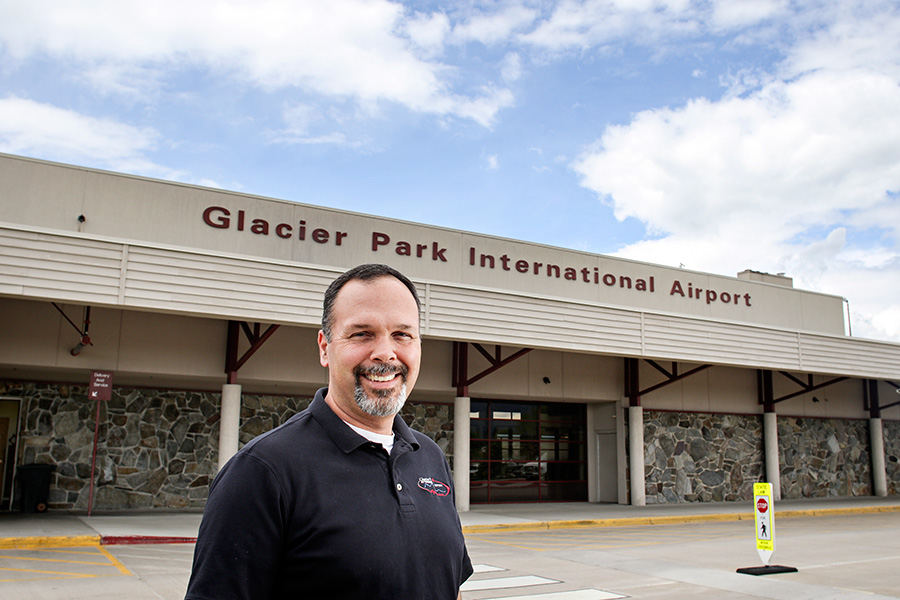From the big windows in his office, Rob Ratkowski can watch every plane that lands and takes off at Glacier Park International Airport. And every year, the number grows.
Northwest Montana’s primary airport is poised for another year of growth, said Ratkowski, 43, who took over as GPIA’s director last year, after serving as deputy director for a decade. In April, the airport saw more than a 6 percent increase in passenger departures over the previous year. If ridership continues to grow, 2017 will top last year’s record-breaking 492,522 passengers that passed through the airport, a nearly 5 percent increase over the previous year. All-time monthly passenger records were set in 10 of the 12 months in 2016, and those records were broken again this year in January, February and April.
“The economy is healthy and people are starting to travel again,” Ratkowski said. “We’ve seen a real big jump in passenger numbers in recent years.”
Ratkowski grew up in the airline industry. With a pilot for a father, some of his earliest memories are in airports. He attended Metropolitan State College in Denver and graduated with a degree in aviation management before getting a job at the city’s Centennial Airport, the second busiest non-commercial airport in the nation. In 2004 Ratkowski came to the Flathead and became deputy director under now-retired GPIA Director Cindi Martin.
“Every paycheck I’ve ever collected in my adult life has been related to the airline industry,” Ratkowski said.
Glacier Park International Airport includes one 9,000-foot-long runway and another 3,500-foot-long-runway, enabling it to handle both commercial and private air traffic. Ratkowski said the airport also serves as a critical resource for first responders trying to fly medical patients in and out of the area and for wildfire fighting efforts.
The airport has a major economic impact. According to the Montana Department of Transportation, GPIA supported more than 2,100 jobs in the area and pumped more than $228 million into the local economy last year.
Ratkowski said the airport not only allows tourists to visit Northwest Montana, but it also lets local businesses share their products and services with outside markets.
“This airport gives people across the country the ability to do business with Kalispell, and it lets Kalispell do business with the world,” Ratkowski said.
Increasing the number of direct flights in and out of the airport has been a top priority in recent years. When Ratkowski arrived here more than a decade ago, the only direct flights went to Seattle, Minneapolis and Salt Lake City. Today, however, you can get to Los Angeles, Las Vegas, Denver, Chicago, San Francisco, Oakland and Portland on one flight. Ratkowski said Glacier AERO, a nonprofit community organization that supports the airport, has played a big role in helping add those direct flights.
Glacier AERO raises money to cover minimum revenue guarantee agreements with airlines that fly in and out of GPIA. Essentially, the organization helps cover the costs of operating new routes. Chairman Dylan Boyle, who is also executive director of the Whitefish Convention and Visitors Bureau, said those agreements helped United Airlines establish direct flights to Chicago and San Francisco in recent years.
The Chicago flights started during the winter of 2014-2015, arriving and departing every Saturday. Once the flights were established, the Whitefish Convention and Visitors Bureau worked with Whitefish Mountain Resort to establish an aggressive marketing campaign to bring skiers and snowboarders to Montana.
The effort worked. United is still operating the direct flights three years later. This summer, the airline is operating daily flights between Chicago and Kalispell.
“We really want to build on the success of these Chicago and San Francisco routes and have them become a year-round service,” Boyle said.
However, the airport will need to grow to keep up with demand. This year, GPIA is adding a third baggage scanner to help process more luggage. The airport has also hired a consultant to explore possible renovations. This year, work will begin on an aviation demand forecast that will help officials determine what improvements will be needed in the coming years. The last airport expansion was in 1999. Ratkowski said big changes could be on the horizon.
“I think we’re going to need a little bit more of everything,” he said. “More ticket counters, more check-in areas and more space.”
